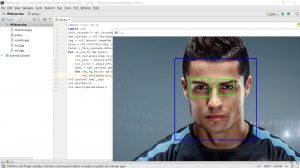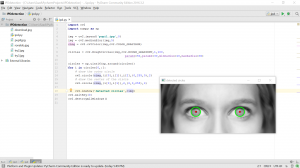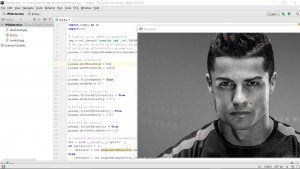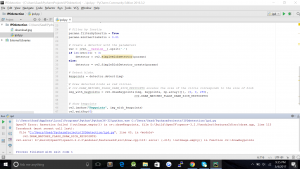These two weeks, a lot of time was spent debugging and working on both photos and webcam (although photos will be focused on from now on).
A lot of time was spent on getting to detect the face and eyes via Haar Cascades. This was accomplished relatively easily for photos with the help of the openly available tutorial, though there was a little hiccup where the program wouldn’t run at all. There was some trouble with the Haar Cascade parameters and learning how to integrate the xml files as the tutorial was based on a different version of OpenCV than I am currently using, but with some digging I was able to find a solution:
After this I tried applying the same method for the webcam by changing some lines of code around with the help of the OpenCV webcam tutorial, and spent a few hours trying to get that to work but wasn’t able to. I followed the steps at https://realpython.com/blog/python/face-detection-in-python-using-a-webcam/ with some changes (I changed the part where the code uses system arguments because I wasn’t using any) but I still struggled to get it to work. Then I came across another helpful resource in https://pythonprogramming.net/haar-cascade-face-eye-detection-python-opencv-tutorial/ and was able to get the face+eye detection working with the webcam, after adding the full paths to the xml files for the cascade parameters (apparently an older version of OpenCV didn’t need the full path)
I still felt like I wasn’t making much progress and all my time and effort was scattered in multiple places so I decided to try and focus on pupil detection for pictures, which I was struggling with using blob detection, so I looked into some other methods and Hough Circles worked out pretty well for me through the tutorials at http://docs.opencv.org/3.1.0/da/d53/tutorial_py_houghcircles.html and of course, changing the parameters around to accommodate for the objects we care about. (is hough circles a viable alternative?)
Using Hough Circles on the Ronaldo photo wasn’t getting me anywhere but soon it was pretty clear to me that the photo wasn’t zoomed in enough and the pupils weren’t visible at all so now I’m trying the method on other eye-focused pictures and that helped a lot:
If I use Haar Cascades, I am already able to detect the eyes which is the area we care about but the challenge there is that I’m not familiar with the concept of how to work with only the detected space (there is a square drawn around both eyes, and I’m not sure how I would go about using only that space and working with it to get to the pupils)
The goal for next week is to integrate the checkerboard pattern and starting to get to the distance tracking, though right now I’m pretty clueless as to how I’m going to accomplish that.





